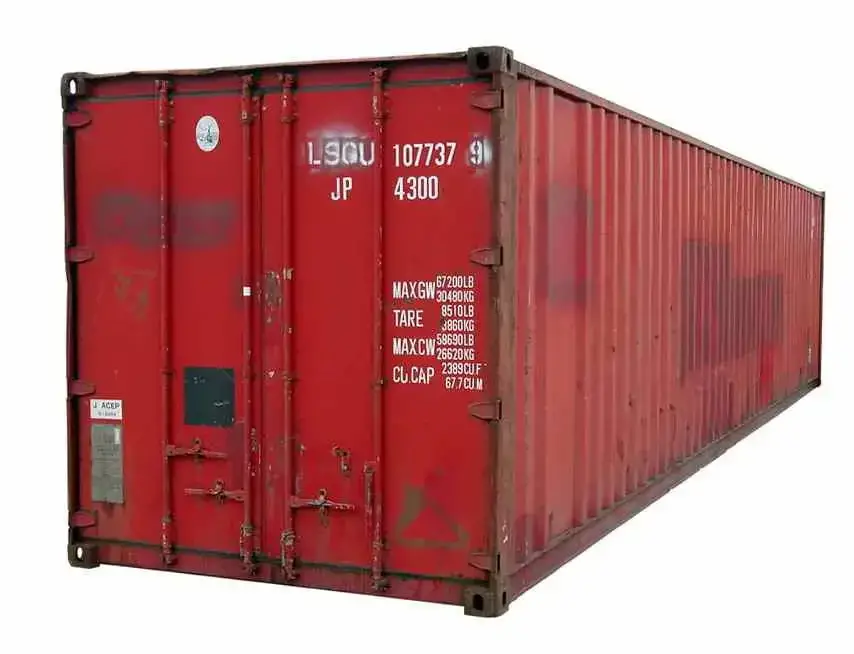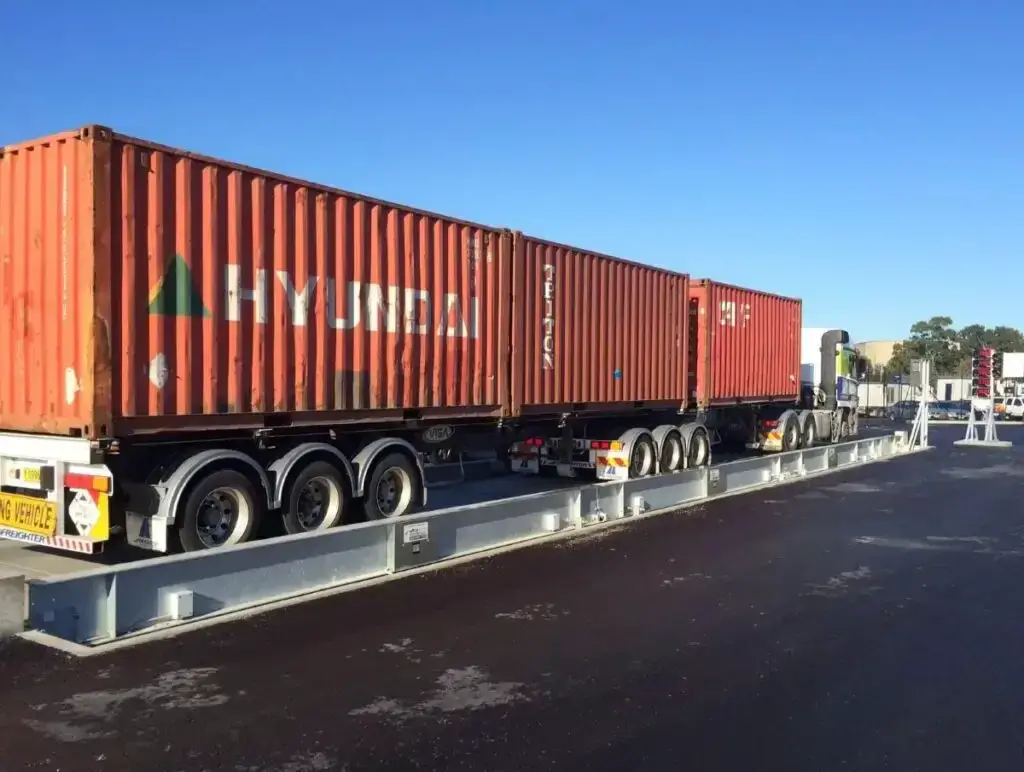Are you aware of the significance of adhering to weight regulations when it comes to shipping containers? Understanding the concept of 20′ container legal weight is crucial for ensuring the safety and efficiency of container transportation.
A. Definition of 20′ container legal weight: The term “20′ container legal weight” refers to the maximum weight limit set by international regulations for a standard 20-foot shipping container. It specifies the total weight a container can carry without compromising structural integrity or posing risks during transportation.
B. Importance of adhering to weight regulations: Adhering to weight regulations is of utmost importance due to various reasons. Firstly, it ensures the safety of transportation by preventing overloading that could lead to accidents or structural damage.
Secondly, complying with weight regulations aids in maintaining the efficiency of logistics operations, ensuring that goods are transported seamlessly from one point to another.
C. Impact of legal weight on container safety and transportation: The legal weight limit plays a vital role in container safety and transportation. Exceeding this limit can result in increased stress on the container structure, potentially leading to collapses or accidents during handling, loading, or even while in transit.
Furthermore, overweight containers may face legal penalties and delays at ports, affecting supply chains and disrupting global trade.
Understanding and adhering to the legal weight restrictions for 20′ containers is crucial for ensuring the safety of goods, optimizing logistics operations, and avoiding unnecessary complications. Therefore, stay informed and compliant to ensure your shipments arrive at their destination securely and efficiently!
Table of Contents
Understanding 20′ Container Legal Weight

A. Tare weight
Definition and significance: To put it simply, tare weight refers to the weight of an empty container without cargo or any additional items. It is an essential measurement as it provides a baseline for determining the weight of the goods being loaded into the container.
Calculation methods for determining tare weight:
- Method 1: Direct Measurement – Involves physically weighing the empty container using calibrated equipment.
- Method 2: Manufacturer’s Specifications – Utilizes the tare weight information provided by the container manufacturer.
- Method 3: Container Tare Weighing Facilities – Some ports and freight terminals offer facilities where containers can be weighed to determine their tare weight.
Read More on The Environmental Benefits of Shipping Container Homes
B. Gross Weight Limit of a 20′ Intermodal Shipping Container
Definition and significance: Gross weight limit refers to the maximum total weight of a loaded container, including the cargo and any additional items such as packaging materials. It is crucial to adhere to this limit to ensure safe transportation and reduce the risk of damage to the container and its contents.
Calculation methods to accurately determine gross weight:
- Method 1: Weighbridge or Scale – Involves placing the loaded container on a weighbridge or scale to measure its total weight.
- Method 2: Individual Item Weighing – Weighing each item individually and summing up their weights to determine the total cargo weight.
- Method 3: Documentation – Referring to packing lists, invoices, or other relevant documents to calculate the total gross weight.
Read More on Modular Container Restaurant: Revolutionary Solutions
C. Payload Capacity of 20′ Shipping Container
Definition and significance: Payload capacity refers to the maximum weight of the cargo that a container can safely carry. It is crucial to understand the payload capacity to prevent overloading, which can lead to accidents, damage to the container, and legal implications.
Factors affecting payload capacity:
- Container Type and Size – Different container types and sizes have varying payload capacities.
- Container Strength and Structural Integrity – Containers with higher structural integrity can typically handle heavier payloads.
- Mode of Transportation – Payload capacity may differ based on the mode of transportation, such as road, rail, or sea.
Importance of complying with legal weight restrictions:
Complying with legal weight restrictions is crucial to ensure the safety of the cargo, personnel, and the overall transportation process. Non-compliance can result in hefty fines, delays, damage to goods, accidents, and legal consequences.
It is essential for shippers and carriers to accurately calculate and comply with the container’s legal weight limits to avoid such issues.
Read More on What is Site Inspection? All You Need to Know
Intermodal Shipping Container Weight Regulations
A. Federal Laws and Regulations
When it comes to container weight, there are specific federal laws and regulations that govern it. These regulations ensure the safety and efficiency of container shipments.
1. Overview of Federal Regulations in the U.S.
In the United States, the Federal Motor Carrier Safety Administration (FMCSA) sets the regulations for container weight. These regulations focus on the maximum allowable weight for trucks transporting containers on the highways.
2. Comparison of Weight Regulations in Different Countries
Weight regulations for containers vary from country to country. It’s important to understand these variations to ensure compliance when shipping internationally. Comparing weight regulations in different countries can help identify any discrepancies and ensure smooth shipping operations.
Read More on Shocking Weight A Container Roof Can Hold
B. 20′ Container Legal Weight Limits in Different Regions
Understanding the 20′ container legal weight limits in different regions is essential for container shipments. Here are some key weight restrictions in major shipping nations/organizations:
1. Weight Restrictions in Major Shipping Nations/Organizations
Major shipping nations and organizations have specific weight restrictions in place to maintain the integrity and safety of container transportation. And so these restrictions ensure proper load distribution and prevent damage to containers and transportation infrastructure.
2. Country-Specific Legal Weight Limits for 20′ Containers
Each country has its own legal weight limits for 20′ containers. It is crucial to be aware of these limits to avoid any non-compliance issues. By adhering to country-specific weight regulations, you can ensure the smooth transportation of your container shipments.
Read More on Sizing Solar Panels to Battery Bank: Maximizing Energy Production
Compliance and Verification Methods
In order to ensure compliance with container weight regulations, various verification methods can be utilized. These methods are designed to accurately measure and verify the weight of containers, providing both accuracy and legal compliance. The following are some commonly employed Compliance and Verification Methods:
20′ Shipping Container Weight Verification Methods
- Weighing before and after loading: This method involves weighing the container both before and after it is loaded. By calculating the difference between the two weights, the net weight of the container can be determined. It is important to ensure that accurate weighing equipment is used for precise measurements.
- Weight displacement calculations: This method involves calculating the weight of the container based on the displacement caused by its presence on a weighing system. The displacement is then converted into weight using specific calculations. This method is commonly used in situations where weighing the container directly may not be feasible.
- Electronic weight systems: Electronic weight systems utilize sensors and electronic components to accurately measure the weight of containers. These systems provide real-time weight measurements, ensuring compliance with legal weight requirements. They are particularly useful for handling large volumes of containers.
Weighbridge/Scale Facilities

- Importance of weighbridge/scale facilities: Weighbridge/scale facilities play a crucial role in verifying container weights. These facilities are equipped with specialized weighing equipment, such as weighbridges or scales, that can accurately measure the weight of loaded containers. They provide a controlled environment that ensures reliable weight verification.
- Availability and accessibility of such facilities: It is essential to have adequate weighbridge/scale facilities available and easily accessible to effectively verify container weights. These facilities should be strategically located to ensure convenience and minimize logistic challenges for businesses and carriers.
- Ensuring accurate weight measurement for compliance: Weighbridge/scale facilities should comply with recognized standards and calibration requirements, ensuring accurate weight measurement. Regular maintenance and calibration of equipment are necessary to uphold reliable weighing practices.
Read More on The Incredible History Of Shipping Containers That Will Amaze You
Consequences of Non-Compliance
Failure to comply with container weight regulations can lead to serious consequences for individuals and businesses involved in shipping and logistics.
Understanding these potential consequences is crucial in order to maintain compliance and ensure the safety and efficiency of operations.
A. Overweight Intermodal Shipping Container Penalties
1. Fines and penalties imposed for exceeding weight limits:
When 20′ intermodal shipping container legal weight limits are exceeded, fines and penalties may be imposed by regulatory authorities. These penalties can vary depending on the jurisdiction and the severity of the non-compliance. It is important to note that these fines can be significant and have a direct impact on the company’s bottom line.
2. Delay and disruption caused by non-compliance:
In addition to fines and penalties, non-compliance with container weight regulations can lead to delays and disruptions in shipping operations.
If containers are found to be overweight during inspections, they may need to be offloaded and reloaded, causing additional time and expenses for both the shipper and the carrier. These delays can have a cascading effect on the entire supply chain, impacting delivery schedules and customer satisfaction.
Read More on Shipping Containers Philadelphia – Unbelievable Agility
B. Safety Considerations in 20′ Shipping Container Legal Weight
1. Structural integrity and safety risks of overloaded containers:
Without a doubt, overloading 20′ containers beyond their legal weight limits can have serious implications for the structural integrity of the containers. Excessive weight can lead to container damage, including dents, bulges, and even structural failures.
These compromised containers pose a significant safety risk to workers involved in handling and transporting them, as well as to other cargo and equipment on board the vessel or vehicle.
2. Road and maritime safety standards:
Non-compliance with container weight regulations also poses risks to road and maritime safety. Overweight containers can negatively impact the stability and maneuverability of trucks, trailers, and vessels, increasing the likelihood of accidents and causing damage to infrastructure.
To ensure the safety of both transportation workers and the general public, it is essential to adhere to weight restrictions imposed by relevant authorities.
Read More on An Exclusive Look At The Different Types Of Shipping Containers
Risk Mitigation and Load Optimization
Weight Distribution and Load Balancing
Proper weight distribution within a container is crucial for safe and efficient transportation. Uneven weight distribution can lead to instability, increased stress on the container, and potential damage to the cargo. By ensuring even weight distribution, you can minimize these risks and enhance container handling.
There are several strategies that can help optimize weight distribution:
- Use load-bearing equipment: Invest in load-bearing pallets, containers, and other equipment to evenly distribute weight across the handling units. These specialized equipment help in maintaining stability and balance, reducing the risk of accidents during transportation.
- Balance heavy and light items: When loading the container, distribute heavy and light items throughout the available space. Placing heavier items near the floor and lighter items on top helps maintain stability and reduces the risk of toppling over.
- Secure cargo properly: Implement appropriate cargo securing techniques such as using straps, braces, or dunnage bags to prevent cargo movement during transit. This ensures that the weight does not shift during transportation, reducing the risk of damage and improving weight distribution.
Read More on Jacksonville Container Movers – Hassle-Free Relocation
20′ Container Legal Weight and Cargo Cost Optimization
The weight of your container plays a significant role in determining shipping costs. Understanding how container weight affects your expenses can help optimize your cargo and reduce overall shipping costs.
Here are some strategies to minimize cargo weight and maximize cost efficiency:
- Choose lightweight packaging materials: Opt for lightweight packaging materials that meet the required strength standards. This reduces the weight of your cargo while still providing adequate protection.
- Consolidate shipments: If possible, consolidate multiple smaller shipments into one container. This reduces the number of containers used and eliminates unnecessary weight associated with additional packaging materials.
- Optimize cargo space: Utilize the available container space efficiently by stacking cargo vertically and utilizing every available inch. This can help reduce wasted space and maximize payload capacity.
By implementing these strategies, you can effectively optimize your container weight and minimize shipping costs without compromising the safety or integrity of your cargo.
Read More on Texas Container Hotel: Unique, Sustainable, Remarkable Stay
Conclusion
A. Summary of Key Takeaways on 20′ Container Legal Weight Limits
- Understanding container weight regulations is crucial in ensuring compliance.
- Compliance and verification methods play a significant role in maintaining safety standards.
- Non-compliance can lead to severe consequences for individuals and businesses.
- Risk mitigation and load optimization techniques can improve efficiency and profitability.
B. Importance of Complying with Legal Weight Limits for 20′ Containers
Adhering to legal weight limits for 20′ containers is essential for various reasons. Firstly, it ensures the safety of the transportation process. Overloading a container increases the risk of accidents, damage to goods, and injuries to workers.
Secondly, complying with weight regulations helps maintain infrastructure integrity. Weight restrictions are in place to prevent excessive strain on roads, bridges, and other transportation infrastructure. By following these rules, we protect the lifespan and condition of these important assets.
Furthermore, non-compliance with legal weight limits can have severe financial implications. Violations may result in hefty fines, penalties, and even legal repercussions. It is, therefore, crucial for businesses to prioritize compliance to avoid detrimental financial consequences.
C. Maintaining Safety Standards and Avoiding Penalties Through Adherence to Regulations
To maintain safety standards and avoid penalties, individuals and businesses must prioritize adherence to weight regulations. This can be achieved through:
- Regularly weighing and verifying container weights before transportation.
- Using reliable compliance and verification methods, such as certified weighing scales.
- Implementing load optimization strategies to maximize efficiency while staying within legal weight limits.
- Educating and training personnel on weight regulations and best practices.
By following these practices, individuals and businesses can ensure they are operating within the legal weight limits for 20′ containers, minimizing risks, maintaining safety standards, and avoiding penalties.
Overall, understanding and complying with legal weight limits for 20′ containers is vital for a safe and efficient transportation process. By prioritizing compliance, individuals and businesses can protect the well-being of workers, maintain infrastructure integrity, and avoid costly penalties.
Read More on Texas Container Ports in the Gulf Coast – The Powerhouse

